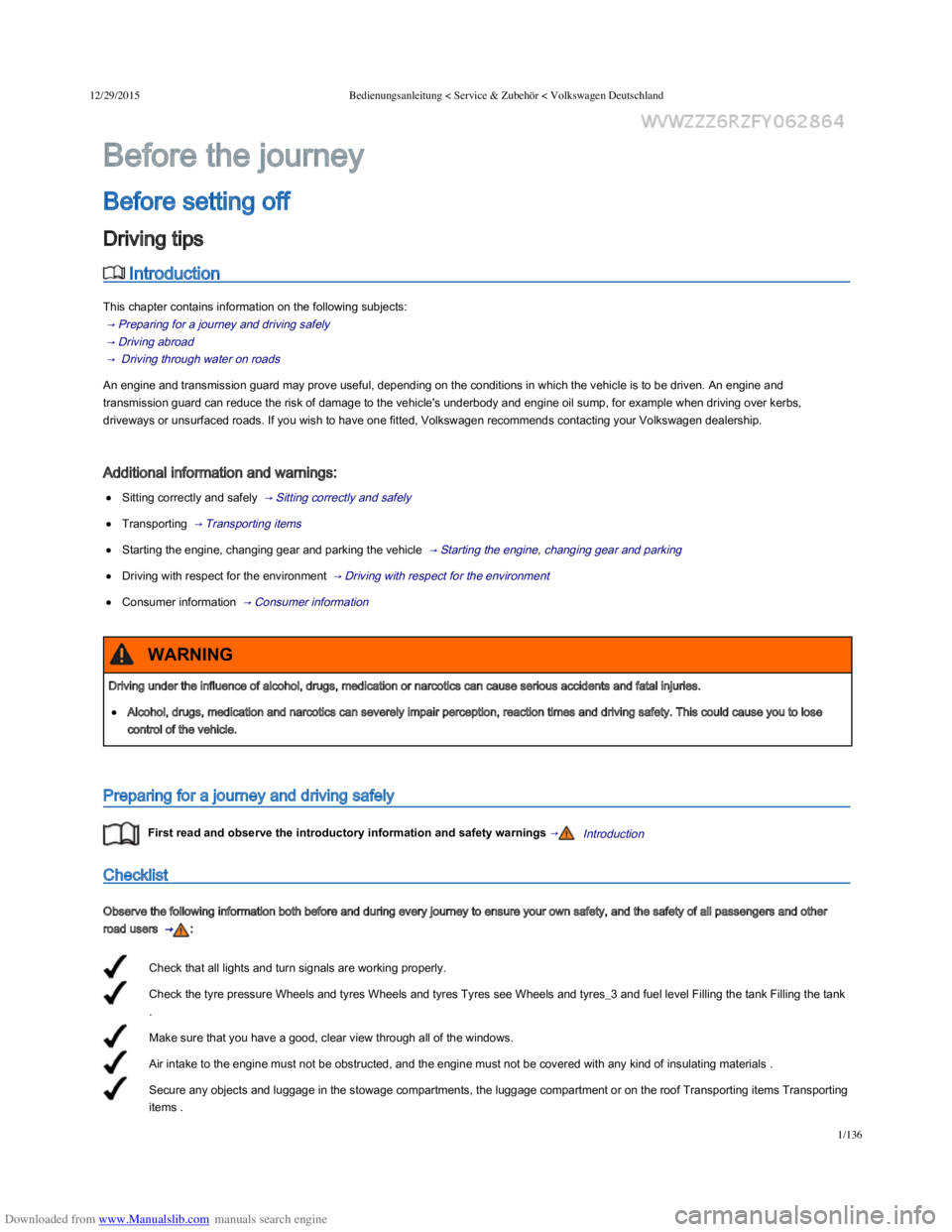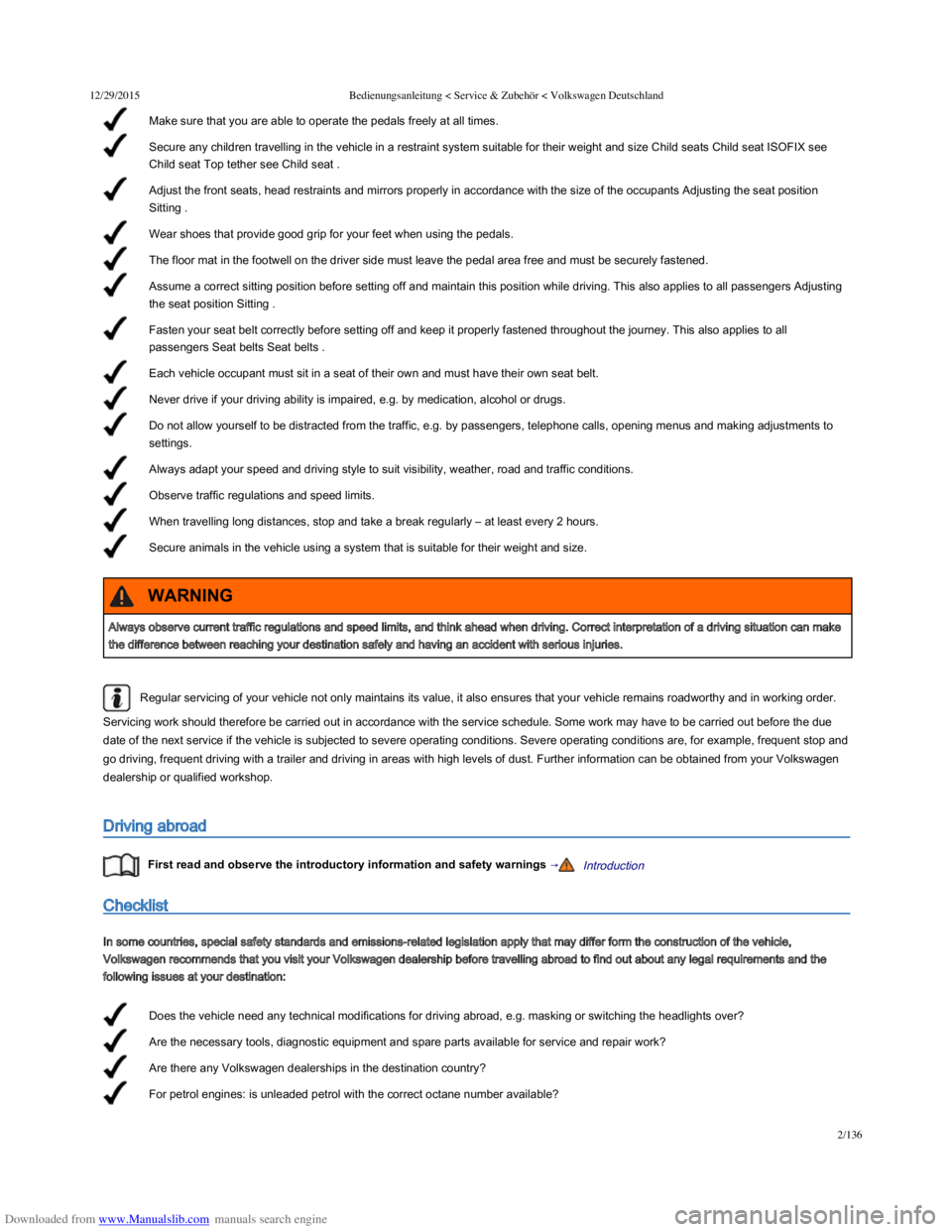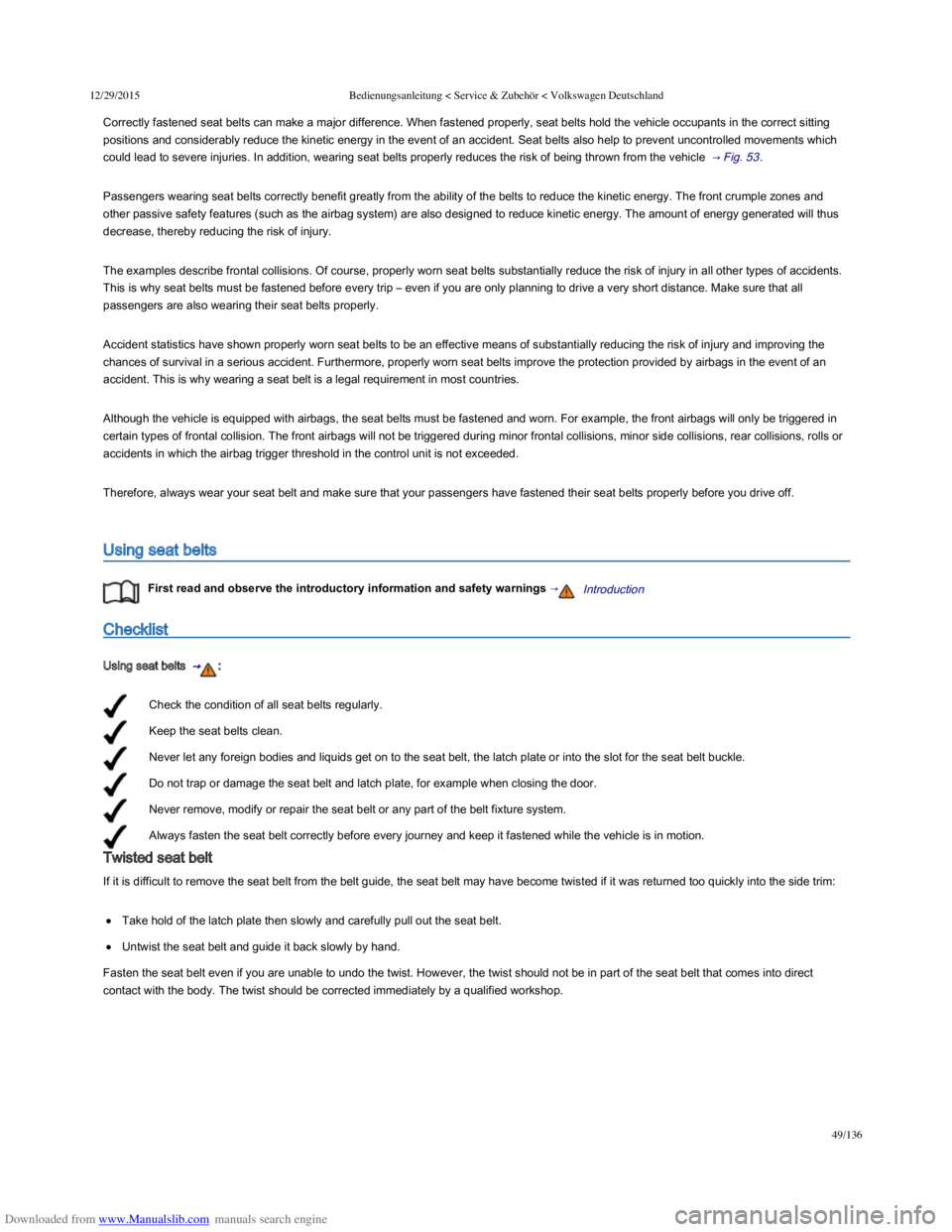air condition VOLKSWAGEN POLO 2015 Owner´s Manual
[x] Cancel search | Manufacturer: VOLKSWAGEN, Model Year: 2015, Model line: POLO, Model: VOLKSWAGEN POLO 2015Pages: 100, PDF Size: 4.14 MB
Page 11 of 100

Downloaded from www.Manualslib.com manuals search engine 12/29/2015Bedienungsanleitung < Service & Zubehör < Volkswagen Deutschland
8/32
Row of switches1) with buttons for:
- Seat heating left and right / → Seat functions
- Traction control system (TCS) → Braking, stopping and parking
- Electronic stabilisation program (ESC) → Braking, stopping and parking
- Electronic stabilisation program sport mode (ESC Sport) → Braking, stopping and parking
- Start/stop system → Pull-away assist systems
- Rear window heating → Heating, ventilating, cooling
- Hazard warning lights → In an emergency
- Indicator lamp for the front passenger front airbag switch-off function → Airbag system
- ParkPilot → ParkPilot
- Sport Select suspension → Sport Select suspension
Infotainment system (factory-fitted)
- Operating display → Infotainment system
- Radio ⇒ BookletRadio,
- Navigation system ⇒ BookletNavigation system,
Controls2) for:
- Heating and fresh air system → Heating, ventilating, cooling
- Air conditioning system (manual) → Heating, ventilating, cooling
- Climatronic → Heating, ventilating, cooling
1) Depending on the vehicle equipment level, there could be a card holder instead of 3 buttons → Stowage areas .
2) The symbols may differ between models.
Lower section of the centre console
Page 36 of 100

Downloaded from www.Manualslib.com manuals search engine 12/29/2015Bedienungsanleitung < Service & Zubehör < Volkswagen Deutschland
1/136
Check that all lights and turn signals are working properly.
Check the tyre pressure Wheels and tyres Wheels and tyres Tyres see Wheels and tyres_3 and fuel level Filling the tank Filling the tank
.
Make sure that you have a good, clear view through all of the windows.
Air intake to the engine must not be obstructed, and the engine must not be covered with any kind of insulating materials .
Secure any objects and luggage in the stowage compartments, the luggage compartment or on the roof Transporting items Transporting
items .
Introduction
This chapter contains information on the following subjects:
→ Preparing for a journey and driving safely
→ Driving abroad
→ Driving through water on roads
An engine and transmission guard may prove useful, depending on the conditions in which the vehicle is to be driven. An engine and
transmission guard can reduce the risk of damage to the vehicle's underbody and engine oil sump, for example when driving over kerbs,
driveways or unsurfaced roads. If you wish to have one fitted, Volkswagen recommends contacting your Volkswagen dealership.
Additional information and warnings:
Sitting correctly and safely → Sitting correctly and safely
Transporting → Transporting items
Starting the engine, changing gear and parking the vehicle → Starting the engine, changing gear and parking
Driving with respect for the environment → Driving with respect for the environment
Consumer information → Consumer information
Preparing for a journey and driving safely
First read and observe the introductory information and safety warnings →Introduction
Checklist
Observe the following information both before and during every journey to ensure your own safety, and the safety of all passengers and other
road users → :
Before the journey
Before setting off
Driving tips
Driving under the influence of alcohol, drugs, medication or narcotics can cause serious accidents and fatal injuries.
Alcohol, drugs, medication and narcotics can severely impair perception, reaction times and driving safety. This could cause you to lose
control of the vehicle.
WARNING
Page 37 of 100

Downloaded from www.Manualslib.com manuals search engine 12/29/2015Bedienungsanleitung < Service & Zubehör < Volkswagen Deutschland
2/136
Make sure that you are able to operate the pedals freely at all times.
Secure any children travelling in the vehicle in a restraint system suitable for their weight and size Child seats Child seat ISOFIX see
Child seat Top tether see Child seat .
Adjust the front seats, head restraints and mirrors properly in accordance with the size of the occupants Adjusting the seat position
Sitting .
Wear shoes that provide good grip for your feet when using the pedals.
The floor mat in the footwell on the driver side must leave the pedal area free and must be securely fastened.
Assume a correct sitting position before setting off and maintain this position while driving. This also applies to all passengers Adjusting
the seat position Sitting .
Fasten your seat belt correctly before setting off and keep it properly fastened throughout the journey. This also applies to all
passengers Seat belts Seat belts .
Each vehicle occupant must sit in a seat of their own and must have their own seat belt.
Never drive if your driving ability is impaired, e.g. by medication, alcohol or drugs.
Do not allow yourself to be distracted from the traffic, e.g. by passengers, telephone calls, opening menus and making adjustments to
settings.
Always adapt your speed and driving style to suit visibility, weather, road and traffic conditions.
Observe traffic regulations and speed limits.
When travelling long distances, stop and take a break regularly – at least every 2 hours.
Secure animals in the vehicle using a system that is suitable for their weight and size.
Does the vehicle need any technical modifications for driving abroad, e.g. masking or switching the headlights over?
Are the necessary tools, diagnostic equipment and spare parts available for service and repair work?
Are there any Volkswagen dealerships in the destination country?
For petrol engines: is unleaded petrol with the correct octane number available?
Regular servicing of your vehicle not only maintains its value, it also ensures that your vehicle remains roadworthy and in working order.
Servicing work should therefore be carried out in accordance with the service schedule. Some work may have to be carried out before the due
date of the next service if the vehicle is subjected to severe operating conditions. Severe operating conditions are, for example, frequent stop and
go driving, frequent driving with a trailer and driving in areas with high levels of dust. Further information can be obtained from your Volkswagen
dealership or qualified workshop.
Driving abroad
First read and observe the introductory information and safety warnings →Introduction
Checklist
In some countries, special safety standards and emissions-related legislation apply that may differ form the construction of the vehicle,
Volkswagen recommends that you visit your Volkswagen dealership before travelling abroad to find out about any legal requirements and the
following issues at your destination:
Always observe current traffic regulations and speed limits, and think ahead when driving. Correct interpretation of a driving situation can make
the difference between reaching your destination safely and having an accident with serious injuries.
WARNING
Page 79 of 100

Downloaded from www.Manualslib.com manuals search engine 12/29/2015Bedienungsanleitung < Service & Zubehör < Volkswagen Deutschland
44/136
The seat heating should be switched off as soon as it is no longer needed. Fuel is otherwise wasted.
Introduction
This chapter contains information on the following subjects:
→ Warning lamp
→ Frontal collisions and the laws of physics
→ What happens to vehicle occupants who have not fastened their seat belts
→ Seat belt protection
→ Using seat belts
→ Fastening and unfastening seat belts
→ Seat belt routing
→ Belt height adjuster
→ Automatic belt retractor, belt tensioner, belt tension limiter
→ Service and disposal of belt tensioners
Check the condition of all seat belts regularly. If the belt webbing, belt connections, belt retractor or seat belt buckle become damaged, the seat
belt in question should be replaced immediately by a qualified workshop → . The qualified workshop must use correct spare parts that are
compatible with the vehicle, equipment level and model year. Volkswagen recommends using a Volkswagen dealership for this purpose.
Additional information and warnings:
Adjusting the seat position → Adjusting the seat position
Airbag system → Airbag system
Child seats → Child seats
Stowage → Stowage areas
Cleaning and caring for the interior → Cleaning and caring for the interior
Accessories, modifications, repairs and renewal of parts → Accessories, modifications, repairs and renewal of parts
Wet upholstery can cause a fault in the seat heating and increase the risk of burns.
Make sure that the seat cushion is dry before using the seat heating.
Do not sit on the seat when wearing damp or wet clothing.
Do not set any damp or wet objects or items of clothing on the seat.
Do not spill any liquids on the seat.
WARNING
To avoid damaging the heating elements, do not kneel on the seat or apply sharp pressure at a single point on the seat cushion and
backrest.
Liquids, sharp objects and insulating materials such as a protective cover or child seat on the seat could damage the seat heating.
If the system starts to emit a smell, switch the seat heating off immediately and have it checked by a qualified workshop.
NOTICE
Seat belts
Page 84 of 100

Downloaded from www.Manualslib.com manuals search engine 12/29/2015Bedienungsanleitung < Service & Zubehör < Volkswagen Deutschland
49/136
Check the condition of all seat belts regularly.
Keep the seat belts clean.
Never let any foreign bodies and liquids get on to the seat belt, the latch plate or into the slot for the seat belt buckle.
Do not trap or damage the seat belt and latch plate, for example when closing the door.
Never remove, modify or repair the seat belt or any part of the belt fixture system.
Always fasten the seat belt correctly before every journey and keep it fastened while the vehicle is in motion.
Correctly fastened seat belts can make a major difference. When fastened properly, seat belts hold the vehicle occupants in the correct sitting
positions and considerably reduce the kinetic energy in the event of an accident. Seat belts also help to prevent uncontrolled movements which
could lead to severe injuries. In addition, wearing seat belts properly reduces the risk of being thrown from the vehicle → Fig. 53 .
Passengers wearing seat belts correctly benefit greatly from the ability of the belts to reduce the kinetic energy. The front crumple zones and
other passive safety features (such as the airbag system) are also designed to reduce kinetic energy. The amount of energy generated will thus
decrease, thereby reducing the risk of injury.
The examples describe frontal collisions. Of course, properly worn seat belts substantially reduce the risk of injury in all other types of accidents.
This is why seat belts must be fastened before every trip – even if you are only planning to drive a very short distance. Make sure that all
passengers are also wearing their seat belts properly.
Accident statistics have shown properly worn seat belts to be an effective means of substantially reducing the risk of injury and improving the
chances of survival in a serious accident. Furthermore, properly worn seat belts improve the protection provided by airbags in the event of an
accident. This is why wearing a seat belt is a legal requirement in most countries.
Although the vehicle is equipped with airbags, the seat belts must be fastened and worn. For example, the front airbags will only be triggered in
certain types of frontal collision. The front airbags will not be triggered during minor frontal collisions, minor side collisions, rear collisions, rolls or
accidents in which the airbag trigger threshold in the control unit is not exceeded.
Therefore, always wear your seat belt and make sure that your passengers have fastened their seat belts properly before you drive off.
Using seat belts
First read and observe the introductory information and safety warnings →Introduction
Checklist
Using seat belts → :
Twisted seat belt
If it is difficult to remove the seat belt from the belt guide, the seat belt may have become twisted if it was returned too quickly into the side trim:
Take hold of the latch plate then slowly and carefully pull out the seat belt.
Untwist the seat belt and guide it back slowly by hand.
Fasten the seat belt even if you are unable to undo the twist. However, the twist should not be in part of the seat belt that comes into direct
contact with the body. The twist should be corrected immediately by a qualified workshop.